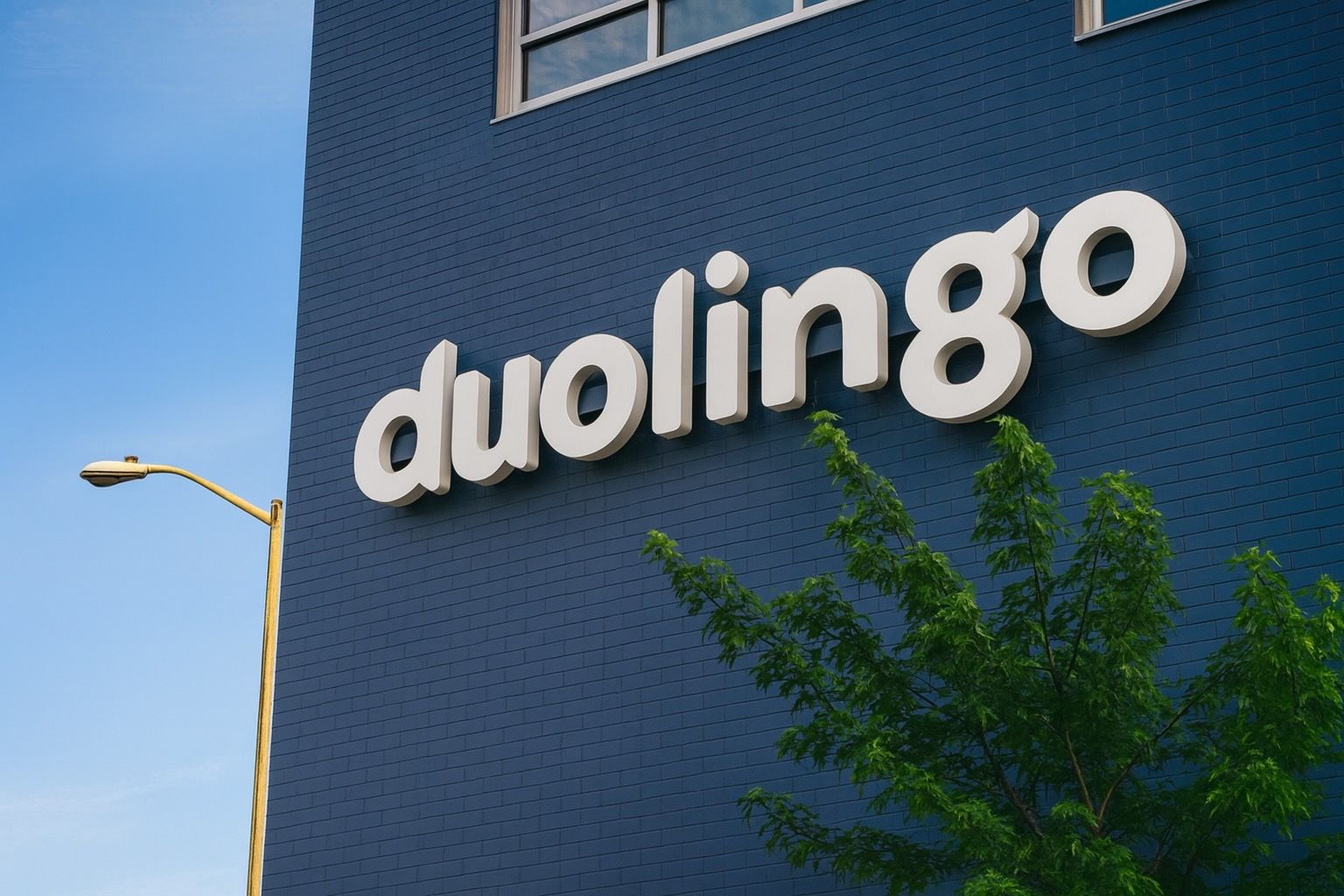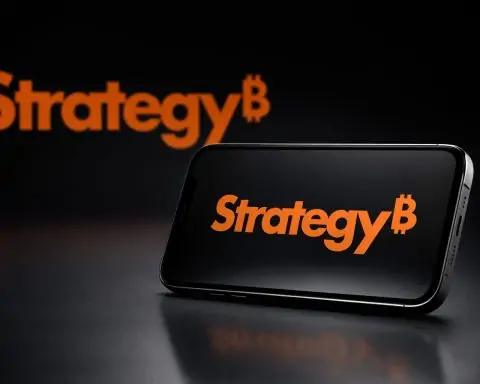- Current Price & Rally: Duolingo (NASDAQ: DUOL) stock jumped about 5% in intraday trading on Oct 8, 2025, hitting roughly $339 per share [1]. It closed around the mid-$330s, rebounding from the low-$300s earlier this week. Despite this rally, shares remain well below their 52-week high of ~$545 (vs. a 1-year low of ~$257) [2].
- Recent News: The spike comes as Duolingo integrates AI and new partnerships – including a LinkedIn profile integration – fueling investor optimism [3] [4]. Meanwhile, co-founder Severin Hacker sold ~$3.2M in stock on Oct 6 at ~$322/share, nearly liquidating his stake [5]. The company will report Q3 2025 earnings on November 5, 2025 (after market close).
- Financials: Q2 2025 saw revenue up 41% year-over-year to $252.3 million [6], with paid subscribers up 37% to 10.9 million [7]. Net income jumped 84% to $44.8 million, and EPS of $0.91 beat estimates of $0.55 [8]. Daily active users (DAUs) hit 47.7 million (+40% YoY) [9]. Buoyed by this growth, management raised full-year revenue guidance to about $1.01 billion (≈36% YoY) [10].
- Analyst Sentiment: Wall Street is broadly bullish. About a dozen firms rate DUOL a “Buy” (vs. ~10 “Hold”), with a consensus price target around $419 [11] (~30% upside). Recent calls include Citigroup (target $375, Buy) [12] and Barclays (target $390, Equal Weight) [13]. KeyBanc upgraded Duolingo to Overweight with a hefty $460 target, arguing “AI innovations are more likely to help, than hurt, monetization” [14]. Zacks also upped DUOL to “Strong Buy”, seeing the recent dip as a buying opportunity [15] [16].
- Outlook: AI Integration & Growth Prospects remain Duolingo’s strengths. The company’s aggressive use of AI has sped up product expansion (148 new courses launched in April alone [17]) and improved margins. Duolingo is extending beyond language learning into chess, music, and more, which CEO Luis von Ahn says gives users “more reasons to engage daily,” boosting retention [18]. Still, risks loom: Big Tech is encroaching (Google’s new AI tutor mode is a “direct Duolingo competitor” [19]), and DUOL’s valuation (>$14B, ~130× earnings [20]) leaves little room for error if growth falters.
Stock Price & Recent Performance
Duolingo’s stock has experienced whiplash in 2025. After a strong first half, DUOL tumbled nearly 50% from summer highs, erasing most of its prior 12-month gains [21]. Over the past three months the stock slid 35%, dramatically underperforming both the edtech industry (+26%) and the S&P 500 (+11%) in that span [22]. This “nasty slide” sent shares down toward the $280s by late September [23]. Investors grew skittish over post-pandemic user trends and fears that emerging AI tools could steal Duolingo’s thunder [24].
October brought a turnaround. This week, DUOL bounced off recent lows, surging roughly 5–6% on Oct 8 alone [25]. Shares climbed from about $320 to the high-$330s, fueled by fresh optimism around the company’s AI strategy and partnerships (more on that below). By Oct 8’s close, Duolingo traded near $338 [26]. Even after this pop, the stock remains well below its early-2025 peak – about 38% below its 52-week high of $544.93 [27]. At current levels, DUOL’s market capitalization stands near $15 billion [28].
Momentum vs. volatility: It’s worth noting Duolingo’s volatility. The stock’s 52-week range spans from roughly $257 to $545 [29], reflecting dramatic swings. Its beta of ~0.86 suggests slightly less volatility than the market on average [30], but recent moves have been extreme. For instance, in August–September, DUOL plunged almost 50% amid a broader tech sell-off, only to rebound in early October. Such swings underline how sensitive this high-growth stock is to sentiment and headlines. Investors have alternated between exuberance over Duolingo’s growth and fear that it got overhyped.
Competitors’ stocks have fared differently, highlighting shifting sentiment in online education. In the last quarter, “Coursera has surged 31%… while Chegg has gained 18.5%. The contrasting trajectories… point to significant shifts in investor sentiment” for edtech stocks [31]. Duolingo’s underperformance relative to peers like Coursera (focused on online courses) and Chegg (education services) suggests company-specific concerns were at play during its slide. Now, as DUOL shows signs of stabilizing, the key question is whether this rebound has legs.
Recent News & Catalysts
Several fresh developments have renewed investor interest in Duolingo:
- AI-Powered Features & LinkedIn Integration: Duolingo has doubled down on an “AI-first” approach. The company’s CEO, Luis von Ahn, recently emphasized that Duolingo is using AI to boost productivity without cutting staff, countering the narrative that AI leads to layoffs [32]. This positive spin on AI has been amplified in the media, painting Duolingo as a responsible innovator. Moreover, Duolingo announced a partnership with LinkedIn that allows users to display their Duolingo language proficiencies on LinkedIn profiles [33]. This effectively links Duolingo to career development – a savvy move tapping into professional networks. News of the LinkedIn integration and Duolingo’s AI initiatives “ignited investor frenzy” and corresponded with the stock’s 5%+ rally on Oct 8 [34].
- Duocon 2025 Announcements: At its annual user conference (Duocon 2025), Duolingo unveiled major product updates that excited analysts. The company showcased new AI-driven features and content expansions across language, music, and other subjects. Citigroup, for example, came away from Duocon reiterating a Buy rating and a $375 price target, citing optimism about Duolingo’s “AI-driven scalability” and recent product momentum [35]. These announcements signaled that Duolingo is not standing still – it’s leveraging AI to roll out content faster and enter new verticals, which could further drive user engagement (and revenue) going forward.
- Insider Stock Sale: On a more cautious note, Duolingo co-founder and CTO Severin Hacker sold 10,000 shareson Oct 6 for about $3.2 million [36]. The sale, at an average price of ~$321, represented roughly 99% of his remaining stake [37]. Such a large insider sale can worry investors about insiders’ confidence. However, Duolingo’s stock did not falter on the news – in fact it rose soon after – suggesting traders looked past it. The company noted the sale in an SEC filing, and it follows a pattern: Hacker had been trimming holdings in prior months (he also sold shares in August and September around $344, $289, etc.) [38]. While insider selling sometimes signals a top, in this case analysts largely shrugged it off, focusing instead on Duolingo’s strong fundamentals and growth (as evidenced by subsequent analyst upgrades).
- Upcoming Earnings (Q3 2025): Duolingo will report its third quarter 2025 results on November 5, 2025 after market close [39]. The earnings call (5:30 p.m. ET webcast) will be closely watched for updates on user growth, new product uptake (like the Chess and music courses), and any revision to outlook. Given the recent stock volatility, any surprises in the Q3 numbers or guidance could spark outsized moves. Investors will look for confirmation that Duolingo’s user base and subscriptions are still climbing healthily into the second half of 2025. Duolingo’s own AI summarizer (the press release’s Rhea-AI Summary) assigned a “Neutral” sentiment ahead of the event [40], indicating no obvious signals – the stage is set for the numbers to speak for themselves.
In summary, Duolingo’s narrative has shifted in early Q4 2025: from gloom in late summer (slowing growth fears, AI threats) to renewed excitement (AI opportunities, strategic partnerships). These recent catalysts have injected optimism and likely contributed to the stock’s recent bounce.
Financial Performance & User Growth
Duolingo’s financial results in 2025 underscore robust growth and improving profitability:
- Blowout Q2 2025: For the quarter ending June 30, 2025, Duolingo reported revenue of $252.3 million, a 41% jump from $178.3 million in Q2 2024 [41]. This top-line beat Wall Street expectations (analysts had ~$240M forecast [42]). Earnings were even more impressive: Duolingo delivered $0.91 EPS, crushing the $0.55 consensus estimate [43]. Net income nearly doubled (+84%) year-on-year to $44.8 million [44], marking one of the company’s first quarters of substantial GAAP profitability. As CEO Luis von Ahn summed up, “Q2 was another strong quarter at Duolingo. Our Daily Active Users grew 40%, in line with our expectations.” [45]
- Surging User Base: Engagement metrics reached record highs. Daily Active Users (DAUs) hit 47.7 million, up 40% year-over-year [46]. Monthly Active Users grew to 128.3 million (+24% YoY) [47] – an enormous audience that solidifies Duolingo’s position as the world’s most popular language-learning platform. Crucially, Duolingo continues to convert a growing share of these users into paying customers. Paid subscribers climbed to 10.9 million, a 37% YoY increase [48]. This helped drive a 46% surge in subscription revenue (to $210.7M) in Q2 [49]. The strong subscriber growth indicates that Duolingo’s freemium model – luring users in for free and upselling them on “Super Duolingo” or the higher “Max” tier – is working at scale.
- Operating Leverage & Margins: Duolingo’s profitability metrics are trending up, aided by efficient scaling and AI-driven improvements. Gross margin rose to over 72% in Q2 [50], and adjusted EBITDA jumped 64% to $78.7 million [51]. The company’s operating leverage is evident: expenses grew much slower than revenues. Notably, Duolingo credited AI for some cost efficiency – AI tools have automated content creation and customer support, trimming costs [52]. The balance sheet remains strong with over $700M in cash (as of mid-year) and minimal debt (debt-to-equity only 0.10) [53]. Liquidity ratios are high (current ratio 2.8×) [54], giving Duolingo flexibility to invest in R&D and acquisitions.
- Raised Full-Year Outlook: On the Q2 earnings call, management hiked 2025 guidance. Duolingo now expects FY 2025 revenue of ~$1.01–1.02 billion [55], up from a prior outlook around $965M. Hitting the midpoint (~$1.015B) would mean ~36% growth over 2024 [56] – an acceleration for a company already at substantial scale. They also guided to an adjusted EBITDA margin near 29% [57], reflecting confidence that profits will scale alongside revenue. This guidance boost, propelled by Q2’s outperformance, signaled to the market that demand remains strong and that Duolingo’s newer ventures (like subscriptions tiers, new courses, and the Duolingo English Test) are contributing meaningfully.
- User Engagement & Product Innovation: Duolingo’s ability to keep users engaged daily underpins its financial success. The company continually introduces gamified features to make learning sticky. In Q2, Duolingo rolled out a new “Energy” system to replace the old Hearts mechanic – rather than punishing mistakes, Energy rewards consistent effort [58]. According to von Ahn, the iOS launch of Energy boosted DAUs, time spent, and conversions to paid plans “all at once,” a rare trifecta [59]. Additionally, Duolingo’s highest subscription tier, Duolingo Max, which offers GPT-4 powered features (like Explain My Answer and Roleplay), saw encouraging uptake. The company even published research showing that Max’s AI-driven “Video Call” feature improved learners’ speaking skills [60] – academic validation that helps justify the premium price. These innovations not only drive revenue (by enticing upgrades) but also fortify Duolingo’s brand as an AI-driven learning platform.
In short, Duolingo’s financial picture through mid-2025 is one of rapid growth across the board – more users, more paying subscribers, and widening profit margins. This performance has provided a strong foundation for the stock, even if investor sentiment temporarily wavered in the face of external fears.
Analysts’ Forecasts & Market Expectations
Wall Street analysts, on balance, remain upbeat about Duolingo’s prospects. The stock carries a consensus “Moderate Buy” rating [61], and price targets suggest significant upside from current levels:
- Consensus Price Target: Around $419 per share, based on ~23 analysts [62]. That implies roughly 25–30% upside from the ~$335–340 range in early October. The target has come down a bit from earlier in the year (when some targets were $450+), reflecting the stock’s pullback. But it’s still notably above the current price, indicating analysts see recovery potential.
- Recent Upgrades/Downgrades: In the last two months, several research firms updated their views:
- Citigroup reiterated a Buy, but trimmed its target from $400 to $375 in mid-September [63], citing general market volatility but confidence in Duolingo’s user growth.
- Barclays in August raised its target from $375 to $390 while maintaining an Equal Weight (neutral) stance [64] – essentially acknowledging Duolingo’s strong execution but cautioning about valuation.
- KeyBanc Capital Markets (KeyCorp) delivered a strong vote of confidence in late August. Analyst Justin Patterson upgraded DUOL to Overweight (from Sector Weight) with a bold $460 price target [65]. Patterson directly addressed the market’s AI fears: earlier in 2025 the stock was “under pressure… on concerns that AI will contract its [market],” but in his view those fears are overblown [66]. He wrote that Duolingo has “several drivers ahead” and that “AI innovations are more likely to help, than hurt, monetization.” [67] In other words, KeyBanc sees Duolingo leveraging AI to make more money (via personalization and new features) rather than losing users to AI alternatives. This bullish call coincided with Duolingo’s trough and may have helped spark renewed interest among institutional investors.
- Zacks Investment Research in early September likewise raised Duolingo to a “Strong Buy”rating [68]. Zacks highlighted Duolingo’s earnings momentum – noting that the consensus EPS estimate for 2025 had risen to $3.12 (up 7.6% in 60 days) and implies +66% YoY growth [69]. They pointed out multiple upward revisions from analysts, reflecting “strong confidence in the company.” [70] Zacks’ analysts concluded that “Duolingo’s dip looks more like an entry point than a red flag,”praising its proprietary data and AI efficiencies driving growth [71].
- Analyst Quotes: Many experts have highlighted Duolingo’s unique position. “Duolingo’s key advantages are its massive user base – a data moat for improving AI – and a highly recognizable brand,” noted one Seeking Alpha analyst recently [72]. This large data advantage means Duolingo can train its recommendation algorithms (like its Birdbrain AI) to keep learners hooked better than smaller rivals can. Another analyst framed Duolingo as “the next great consumer platform,” pointing to its 41% revenue growth, record profits, and expanding margins as evidence that monetization is strengthening [73]. However, some caution remains: a Forbes analysis in September observed the stock’s 20% slide and warned of “decelerating active user growth” as a potential concern if the trend continued [74].
- Target Price Spread: Price targets among analysts range fairly widely – roughly from the mid-$300s up to that $460 high mark. The most bullish forecasts (>$450) imply the stock could revisit all-time highs if Duolingo executes perfectly and market sentiment fully rebounds. The more conservative targets (~$300–$350) suggest the stock is fairly valued or only slightly undervalued after its fall. Notably, no major analyst has a “Sell” on Duolingo (only 1 out of ~24 analysts rates it Underperform [75]). The majority are in Buy/Overweight camp, indicating a general Street view that Duolingo will outperform the market from here.
- Long-Term Vision: Analysts projecting further out, into 2026 and beyond, see Duolingo continuing a high-growth trajectory. The consensus calls for 26% sales growth in 2026 after ~36% in 2025 [76], suggesting only a moderate slowdown as the revenue base gets larger. Profitability is expected to ramp as well: the 2025 EPS of ~$3+ could rise another ~40% in 2026 [77] if all goes well. Some analysts have coined Duolingo a potential “AI hyperscaler at a discount,” arguing that at ~13x 2024 sales the stock is not expensive considering its 40% growth (especially compared to pricier AI-driven peers) [78]. The bullish narrative is that Duolingo could evolve from a niche app into a broad consumer learning platform, capturing a growing share of the $60 billion language learning market (and even expanding that market with new subjects).
In summary, expert sentiment leans positive – Duolingo is widely seen as a category leader with significant runway. The recent pullback was interpreted by several analysts as an opportunity, provided the company keeps delivering strong results. Of course, these forecasts hinge on Duolingo maintaining its growth streak and fending off rising competition, which leads us to the competitive landscape and risks.
Competitive Positioning in EdTech
Duolingo operates at the intersection of consumer tech and education (edtech), where it has carved out a dominant position in language learning. But competition is heating up, both from traditional rivals and tech giants moving into its turf.
Market Leadership: Duolingo is currently the top-grossing education app on both iOS and Android globally [79]. Its gamified approach (streaks, points, cute mascot Duo the owl) and huge variety of courses (over 40 languages) have given it a massive user lead. With 128 million MAUs, Duolingo’s user base far exceeds that of any single direct language-learning competitor (apps like Babbel, Rosetta Stone, Busuu have user counts in the single-digit millions or low tens of millions). This scale gives Duolingo a network effect and data advantage – more users generate more data to improve the app’s AI personalization (Birdbrain AI), making the learning experience better, which in turn attracts more users. It’s a virtuous cycle that new entrants will struggle to replicate quickly.
Expansion Beyond Languages: Uniquely, Duolingo is leveraging its platform to expand into new educational verticals. In late 2023 it launched Duolingo Math, and in April 2025 it launched a Chess course, with Music courses in development. The Chess course, notably, became Duolingo’s fastest-growing launch ever, hitting “over one million DAUs by quarter end” on iOS alone [80]. “That’s just on iOS and in English,” CEO von Ahn noted, indicating far more growth potential as Chess rolls out to Android and other languages [81]. This success proved that Duolingo’s gamified teaching model can translate to subjects beyond languages. Each new subject *“not only expands the addressable market but also increases user retention by giving learners more reasons to engage daily,” as analysts observed [82]. In other words, someone who might have stopped using Duolingo after achieving their language goal might stick around to play chess puzzles or learn piano basics. This multi-subject strategy positions Duolingo as a broader learning and skill-building platform, potentially capturing mindshare (and wallet share) from users interested in lifelong learning and hobbies.
Traditional Competitors: In the language-learning niche, Duolingo does face traditional competitors like Babbel, Rosetta Stone, Memrise, and others. However, Duolingo’s freemium model (free to use, optional paid perks) and massive content library have made it tough for paid-only services to match its growth. Some competitors, like Rosetta Stone, pivoted to enterprise and K-12 offerings. Babbel, a European rival, remains a strong paid app especially in Europe, but its scale (~10M subscriptions sold historically) still trails Duolingo’s reach. So far, no single app has achieved the global cultural presence of Duolingo – the green owl meme, 16+ million TikTok followers (Duolingo’s social media virality is itself a competitive moat), and over half a billion downloads of the app. This brand recognition gives Duolingo a leg up in user acquisition; many language-curious learners instinctively start with Duolingo.
Big Tech & AI Competitors: Perhaps the most significant competitive threat on the horizon comes from tech giants integrating AI into learning tools. In late August, Google announced major AI upgrades to its Translate app, including an “interactive language practice mode” that effectively “turns Translate into a personal tutor” [83]. This feature provides live conversational practice and exercises tailored to the user’s level – directly encroaching on Duolingo’s territory. Google initially launched it for a few language pairs (e.g. English-Spanish) and limited geographies [84], but its ambitions are clear. With Google’s massive resources and distribution (Translate has over 1 billion users), its move “positions Translate as a direct Duolingo competitor in the $60B language-learning market.” [85]. This underscores a key risk: if general-purpose apps like Google Translate become more like Duolingo, users may not see the need to use a separate dedicated app for language learning.
Duolingo’s defense here is to continue differentiating – by gamification, community, and breadth of content – and possibly to partner rather than compete head-on. (Interestingly, Duolingo was one of the launch partners integrating with OpenAI’s ChatGPT plugins earlier in 2023, showing it’s willing to ride bigger tech waves to its advantage.) The LinkedIn integration mentioned earlier is another example: by linking language learning to career profiles, Duolingo does something Google doesn’t.
Other big players like Microsoft and Apple have also dipped into language learning indirectly (e.g., Microsoft’s AI chatbot can practice conversations, Apple’s Translate app exists but is basic). Coursera, while not a direct language competitor, is a large edtech platform focused on accredited courses and certificates, often in partnership with universities. Coursera is more enterprise and professional-skills oriented, and as noted, its stock has outperformed recently [86], but it serves a different use-case than Duolingo’s bite-sized learning.
Competitive Moats: Duolingo’s management frequently cites their “AI and data moat”. Years of user interaction data feed Birdbrain, Duolingo’s AI, which personalizes lessons in a way competitors struggle to match [87] [88]. The company’s fun, addictive design also acts as a moat – for many users, learning on Duolingo feels like playing a game, an experience not easily replicated by more utilitarian tools. Finally, Duolingo’s broad international reach (courses teaching languages from Irish to Japanese to Swahili) attracts a global audience; smaller apps often focus on a few popular languages. This reach helped Duolingo become a top app in countries worldwide, not just English-speaking markets.
In conclusion, Duolingo is currently the leader in its niche, but it’s aware that to stay on top it must keep innovating. The edtech and language-learning space is evolving with AI, and Duolingo’s strategy is clearly to be at the cutting edge of that trend, rather than be disrupted by it. Its competitive positioning is strong, but investors should watch how the Google Translate AI tutor rollout progresses and whether Duolingo’s user engagement can hold up if big tech funnels their billions of users toward competing solutions.
Risks and Opportunities
Like any high-growth tech stock, Duolingo faces a mix of notable risks and exciting opportunities as we look ahead.
Key Risks:
- AI Disruption vs. Adoption: Ironically, the same trend that has propelled Duolingo – artificial intelligence – could also threaten it. There’s a bear case that freely available AI language models or chatbots might one day render Duolingo’s app less essential. For example, one could practice a language by chatting with AI (like ChatGPT or Google’s Bard) instead of following Duolingo’s curriculum. Some investors feared “AI-powered rivals could soon be eating into Duolingo’s dominance in language learning.” [89] These concerns contributed to the stock’s sell-off in mid-2025. However, Duolingo is integrating AI proactively (in-app AI features, partnerships with AI providers) to remain the platform of choice rather than cede ground. The risk is that if Duolingo missteps or competitors’ AI proves superior, user growth could slow. So far, analysts like KeyBanc argue Duolingo’s embrace of AI will help more than hurt [90] – but this is a critical area to watch.
- Intensifying Competition: As discussed, Google’s entry into AI-driven language practice is a serious competitive threat on the horizon [91]. Other big players could follow suit. Additionally, smaller competitors can nibble at niches – e.g., Babbel focusing on live tutoring add-ons, or Memrise leveraging user-generated content. If Duolingo’s user experience advantage narrows, it may need to increase marketing spend or lower prices to compete, which could hurt margins. Chegg, Inc., while different in focus (homework help, tutoring), has also started offering language learning after acquiring Busuu in 2022. The broader edtech sector is crowded, and switching costs for consumers are relatively low (a user can try multiple apps). Duolingo must rely on its brand and continually refreshed content to retain users.
- Valuation & Sentiment Swings: Even after the stock’s correction, Duolingo trades at high valuation multiples – around 130× trailing earnings [92] and over 10× forward sales. This leaves the stock vulnerable to macro pressures like rising interest rates or rotations out of growth stocks. Any hint of growth deceleration can be punished severely (as seen when the stock slid 35% in 3 months [93] despite beating earnings, likely because traders took profits and worried about the AI competition narrative). The stock’s beta below 1 might understate its real volatility; Duolingo has shown it can swing wildly on sentiment. New investors should be prepared for a bumpy ride and potential large swings around earnings or news.
- Post-Pandemic Engagement: Duolingo saw a boom in engagement during COVID-19 lockdowns (2020–21) as millions took up language learning from home. There is a lingering risk that user growth could naturally slow as that cohort normalizes their routines. A Forbes analysis noted “worries of decelerating active user growth” after the pandemic peak [94]. So far, Duolingo has kept growth high (DAUs +40% YoY is impressive in 2025 [95]), but as the user base expands, each percentage gain represents a larger absolute number of new users needed. If quarterly active user metrics were to flatten or decline, it would likely spook investors and pressure the stock.
- Execution Risks: Launching new courses and entirely new subject apps (music, math, etc.) is not guaranteed to succeed. User taste can be fickle – a poorly received feature or price change could hurt Duolingo’s reputation (for instance, past backlash occurred when Duolingo over-monetized heart refills, prompting feature reworks). There’s also reliance on app store ecosystems (Apple/Google) – any changes in those platforms’ policies or fee structures can impact Duolingo. And while Duolingo’s freemium model has worked well, the company must continuously convert free users to paid; if conversion rates stall, revenue growth could slow even if user growth stays high.
Major Opportunities:
- Continued User Growth & Monetization: The sheer size of Duolingo’s audience is a gold mine. With ~50 million DAUs and 128 million MAUs [96], even small improvements in monetization (ads or subscription uptake) can yield large revenue gains. Duolingo is still penetrating emerging markets and could easily cross 150M+ MAUs in the next year given current trajectories. Each new user acquired at near-zero marginal cost (thanks to word-of-mouth and virality) is an opportunity to upsell a subscription or show ads. The company recently noted it increased subscription ARPU by 6% YoY via mix-shift to higher tiers, “rather than simple price hikes” [97] – indicating there is room to grow revenue per user by offering more value (like the Max tier with AI features). As long as the user base expands and engagement stays high, Duolingo’s financials can compound impressively.
- New Subjects & Vertical Expansion: Duolingo’s push beyond language learning is just beginning and could open entirely new markets. The success of the Chess course (over 1 million DAUs in a quarter [98]) hints at a future where Duolingo isn’t just a language app but a multi-subject learning app – a “Netflix of Education” model, where many skills can be learned in one place. Upcoming Music courses (an area with huge global interest) and the existing Math app target broad user segments from kids to adults. If Duolingo can replicate its gamified formula in these domains, it could greatly increase the total addressable market (TAM). Chess alone added a new kind of user to Duolingo. The company’s acquisition of NextBeat, a music gamification startup [99], shows it’s serious about building engaging non-language content. These initiatives diversify Duolingo’s offerings, potentially reducing reliance on any single category and extending user lifetime value (as users might stick with the app to learn multiple things over years).
- Corporate and Education Partnerships: While Duolingo is mostly consumer-focused, there’s an opportunity to partner with schools, companies, and governments. The Duolingo English Test (DET) is one example: it’s an alternative to TOEFL/IELTS for language certification, accepted by thousands of universities. As DET adoption grows, it not only provides revenue but also cements Duolingo’s brand in formal education. Additionally, Duolingo’s content could be used in classrooms or corporate training for language learning – a largely untapped channel so far. If Duolingo pursued enterprise deals (similar to how LinkedIn Learning or Coursera do with companies), that could open a new revenue stream. Their recent LinkedIn integration hints at recognizing the value of aligning with professional development [100].
- AI Advantage and Cost Efficiency: Duolingo has turned AI into an ally to accelerate product development. By using GPT-4 and in-house AI (Birdbrain), the company massively sped up course creation – “nearly 150 new courses in less than a year,” whereas it took a decade to develop the first 100 courses [101]. This is an extraordinary increase in productivity. More courses = more user engagement (people stick around to learn new languages/topics). And impressively, Duolingo achieved this without ballooning costs – AI actually kept content creation costs in check, contributing to higher margins [102]. Going forward, Duolingo’s early adoption of AI may let it scale in ways competitors can’t, launching content for niche interests or personalized lessons tailored to each user. If AI helps each user learn faster or more enjoyably, it could improve retention and conversion rates, feeding the growth loop. Duolingo’s CEO put it plainly: “We’re using AI to give everyone a personal tutorexperience,” something that traditionally would be prohibitively expensive but at scale can be done in-app. The company’s commitment to staying at the forefront of edtech AI – without replacing its human staff – sets a model that could keep it ahead of the curve.
- Analyst and Investor Confidence: As a public company only since 2021, Duolingo now has a couple of years of track record. It has consistently beaten revenue estimates and shown a clear path to profitability, which not all high-growth tech firms manage. The fact that 91% of DUOL shares are institutionally owned [103] suggests that smart money sees it as a long-term winner. If Duolingo continues to execute, we could see renewed inflows from growth investors. Already, during the Q3 dip, big names like Vanguard, Invesco, and T. Rowe Price increased their positions in Duolingo stock [104] [105], indicating conviction that the company’s fundamentals remain strong. This institutional support can be an opportunity in itself – providing share price stability and potential buying pressure on positive news.
Bottom Line: Duolingo’s story carries high expectations but also justified excitement. The company is riding powerful trends – mobile learning, AI, gamification – and has a beloved brand with global reach. It must navigate formidable challenges, from Silicon Valley giants entering its domain to ever-present volatility in tech stocks. As one market observer put it, Duolingo offers a “compelling long-term investment profile” by “balancing innovation with profitability.” [106] [107] So far in 2025, it has struck that balance deftly, turning innovation into user growth and financial gains.
Investors should keep an eye on upcoming earnings (Nov 5) and any updates on user metrics or guidance. Also crucial will be management’s commentary on the competitive landscape – e.g., do they see any impact from Google’s AI features, and how is engagement with new offerings like Chess and Music? Duolingo has proven it can grow rapidly; the next chapter is about proving longevity and defending its moat in an evolving edtech arena.
Analyst Recommendations & Final Thoughts
Wall Street’s overall stance on DUOL is positive, but not without caveats. According to MarketBeat, the stock currently has 1 Strong Buy, 12 Buys, 10 Holds, and 1 Sell rating – translating to a consensus Moderate Buy [108]. The average target price of ~$419 suggests analysts see meaningful upside as Duolingo capitalizes on its momentum [109]. Bulls argue that the company’s expansion and tech advantages justify a premium valuation. For example, KeyBanc’s upgrade implies Duolingo’s recent lows were a mispricing, with their team “impressed by the new risk/reward profile” after the drop [110]. They and others believe DUOL’s growth drivers (AI, new subjects, subscription upselling) remain intact and even strengthened by the company’s execution.
That said, a few observers urge caution. The lone Sell rating and some Hold ratings likely come from those worried about competition or valuation. If the broader market turns risk-averse, high-fliers like Duolingo can be dragged down regardless of performance. And if Duolingo’s results ever slip – say, user growth dips to single digits or margins stop improving – sentiment could swing negative quickly.
For now, Duolingo enters late 2025 with significant tailwinds. “Since day one, we’ve had a bold mission: to build the best education in the world and make it universally available,” CEO von Ahn has stated [111]. That mission, ambitious as it is, appears to be resonating with millions of learners and paying off for investors. The stock’s recent resurgence on “AI buzz” shows how central innovation is to Duolingo’s equity story – it must keep surprising and delighting users (and investors) to sustain its valuation.
In summary, Duolingo, Inc. (DUOL) presents a dynamic mix of high growth, technological innovation, and competitive challenges. It’s a leader in a growing market, with analysts expecting strong earnings and revenue expansion into 2026. The company’s embrace of AI – from personalized lessons to new features – is both its differentiator and something it must continuously get right. Prospective investors should weigh the opportunities of Duolingo’s expanding ecosystem and proven ability to execute, against the risks of lofty expectations and fast-evolving competition. As of October 2025, the owl is flying high once more, and many experts are betting that this rebound is only the beginning of Duolingo’s next chapter [112].
Sources: Duolingo Investor Letter & Press Releases; EdTech Innovation Hub (Oct 2025) [113] [114]; MarketBeat Insider Report (Oct 7, 2025) [115] [116]; Nasdaq/Zacks Analyst Commentary [117] [118]; AInvest Market Update (Oct 8, 2025) [119] [120]; TS2.tech News Roundup [121]; Benzinga KeyBanc Upgrade analysis [122]; and Wall Street analyst consensus data [123].
References
1. www.ainvest.com, 2. www.marketbeat.com, 3. www.ainvest.com, 4. www.ainvest.com, 5. www.marketbeat.com, 6. www.edtechinnovationhub.com, 7. www.edtechinnovationhub.com, 8. www.marketbeat.com, 9. www.edtechinnovationhub.com, 10. www.nasdaq.com, 11. www.marketbeat.com, 12. www.marketbeat.com, 13. www.marketbeat.com, 14. www.benzinga.com, 15. www.marketbeat.com, 16. www.nasdaq.com, 17. www.nasdaq.com, 18. www.nasdaq.com, 19. ts2.tech, 20. www.marketbeat.com, 21. www.marketbeat.com, 22. www.nasdaq.com, 23. www.marketbeat.com, 24. www.marketbeat.com, 25. www.ainvest.com, 26. www.ainvest.com, 27. www.marketbeat.com, 28. www.marketbeat.com, 29. www.marketbeat.com, 30. www.marketbeat.com, 31. www.nasdaq.com, 32. www.ainvest.com, 33. www.ainvest.com, 34. www.ainvest.com, 35. www.ainvest.com, 36. www.marketbeat.com, 37. www.marketbeat.com, 38. www.marketbeat.com, 39. www.stocktitan.net, 40. www.stocktitan.net, 41. www.edtechinnovationhub.com, 42. www.marketbeat.com, 43. www.marketbeat.com, 44. www.edtechinnovationhub.com, 45. www.edtechinnovationhub.com, 46. www.edtechinnovationhub.com, 47. www.edtechinnovationhub.com, 48. www.edtechinnovationhub.com, 49. www.edtechinnovationhub.com, 50. www.nasdaq.com, 51. www.edtechinnovationhub.com, 52. www.nasdaq.com, 53. www.marketbeat.com, 54. www.marketbeat.com, 55. www.nasdaq.com, 56. www.nasdaq.com, 57. www.nasdaq.com, 58. www.edtechinnovationhub.com, 59. www.benzinga.com, 60. www.edtechinnovationhub.com, 61. www.marketbeat.com, 62. www.marketbeat.com, 63. www.marketbeat.com, 64. www.marketbeat.com, 65. www.benzinga.com, 66. www.benzinga.com, 67. www.benzinga.com, 68. www.marketbeat.com, 69. www.nasdaq.com, 70. www.nasdaq.com, 71. www.nasdaq.com, 72. stockanalysis.com, 73. stockanalysis.com, 74. stockanalysis.com, 75. www.marketbeat.com, 76. www.nasdaq.com, 77. www.nasdaq.com, 78. stockanalysis.com, 79. www.edtechinnovationhub.com, 80. www.edtechinnovationhub.com, 81. www.edtechinnovationhub.com, 82. www.nasdaq.com, 83. ts2.tech, 84. ts2.tech, 85. ts2.tech, 86. www.nasdaq.com, 87. chiefaiofficer.com, 88. chiefaiofficer.com, 89. www.marketbeat.com, 90. www.benzinga.com, 91. ts2.tech, 92. www.marketbeat.com, 93. www.nasdaq.com, 94. stockanalysis.com, 95. www.edtechinnovationhub.com, 96. www.edtechinnovationhub.com, 97. www.nasdaq.com, 98. www.edtechinnovationhub.com, 99. www.edtechinnovationhub.com, 100. www.ainvest.com, 101. www.nasdaq.com, 102. www.nasdaq.com, 103. www.marketbeat.com, 104. www.marketbeat.com, 105. www.marketbeat.com, 106. www.nasdaq.com, 107. www.nasdaq.com, 108. www.marketbeat.com, 109. www.marketbeat.com, 110. www.marketbeat.com, 111. www.edtechinnovationhub.com, 112. www.nasdaq.com, 113. www.edtechinnovationhub.com, 114. www.edtechinnovationhub.com, 115. www.marketbeat.com, 116. www.marketbeat.com, 117. www.nasdaq.com, 118. www.nasdaq.com, 119. www.ainvest.com, 120. www.ainvest.com, 121. ts2.tech, 122. www.benzinga.com, 123. www.marketbeat.com







